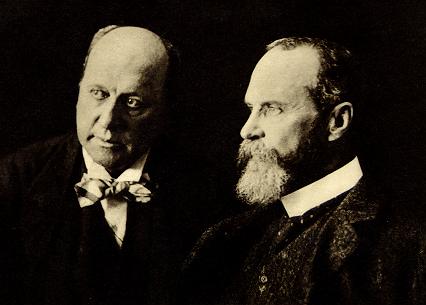“There’s every risk of an overshoot”
Because of the bloated monetary base there has been much concern recently about the supposed risk of future inflation. There are at least four important misconceptions associated with this issue, and I’ll try to address all four in this post. The first misconception is that it will be difficult to pull the excess reserves back out of circulation after the economy recovers and interest rates rise to a more normal level. As Hall recently pointed out, if we continue to pay interest on reserves it would not be necessary to pull those reserves out of circulation in the future, just pay enough interest for banks to want to continue holding them. But for the moment let’s assume that’s not feasible. In the following quotation from the WSJ, Kenneth Rogoff expresses a widely held fear:
“It’s very difficult to pump this money in and pull it out later,” says Kenneth Rogoff, a professor of economics at Harvard University. “There’s every risk of an overshoot.”
Let me first say that Rogoff has been very good on the need for an explicit inflation target for the Fed; in fact I seem to recall him suggesting a target of 6%, so he is not someone oblivious to the need for monetary stimulus. In addition, it’s easy to make generalizations when talking to the press, so I really don’t know whether he is actually all that worried about this issue. But some people clearly are. And this reflects a misunderstanding of monetary theory.
During the 1960s, 1970s and early 1980s there was a lot of concern about inflation gaining momentum, and then being hard to stop. Once inflation expectations start to rise, wage increases accelerate, and the core inflation rate also rises. At this point it is hard to put the genie back in the bottle. Reducing inflation once expectations have risen; runs into the well-known Phillips Curve problem. But that problem should never occur unless the central bank is grossly negligent. After 1982 central banks around the world figured out how to keep inflation under control. The key is to tighten monetary policy aggressively at any sign of an upswing in inflation expectations. As long as the Fed doesn’t let nominal/indexed bond spreads exceed 3%, there will be no severe problem of inflation overshooting. (That’s not to say they will be perfect, there certainly may be the occasional problem of slightly above target inflation.)
The second misconception is that monetary stimulus requires a massive increase in the monetary base. I have said from the beginning that if my policy were pursued the monetary base would probably be much lower than it is today. Now that the world’s leading expert on interest payments on reserves has endorsed my signature proposal, let’s look more closely at how the plan would actually work.
Before the crisis there was about $800 billion in cash, $80 billion in required reserves, and less than $8 billion in excess reserves. (I don’t recall the exact figures, but it doesn’t matter.) After the Fed started paying interest on reserves in early October, excess reserves ballooned up to about $800 billion, 100 times the normal level. With a penalty rate on excess reserves that number would go back down to less than $8 billion. In that case to prevent hyperinflation the Fed would need to pull almost all the extra $800 billion out of circulation. It’s hard to know how big a QE would be needed with a penalty rate on excess reserves; it depends on how credible the policy is. But in my view less than $100 billion would be required to hit any reasonable inflation or NGDP target.
Why so little? Because with a penalty rate on excess reserves all the extra $100 billion would go into cash in circulation. I did my dissertation on cash, and I can tell you that cash demand is nothing like what we learn in our textbooks. Because of the fear of theft, transactions balances are amazing small, even at near zero interest rates. Many people only carry a few hundred dollars, or even less. Where is the other more than $2000 per capita? Hoarded by tax evaders, criminals, and foreigners. And it is very costly for those groups to quickly adjust the size of their cash balances. They prefer the anonymity of cash, and thus often don’t have large amounts of financial assets to exchange for cash when rates fall.
I have no idea what would happen if the Fed tried to force even another $100 billion into circulation. It is possible that it would be put into safety deposit boxes, if T-bill yields went negative. But I think a much more likely outcome is that even before they got anywhere near $100 billion extra cash in circulation, there would be such a reaction in inflation sensitive markets (commodities, stocks, bond yields) that the Fed would fear overshooting their nominal target. It would be easy to generate 2% expected inflation, or 5% NGDP growth. To summarize, although I often do thought experiments about the Fed doubling the money supply, keep in mind that in the real world a bloated base is a sign of failure, of deflationary policies (i.e. the U.S. 1933, Japan 2002, the U.S. 2008.) I don’t expect my proposal to fail, and hence I believe the base would be much lower.
[BTW, should I start calling my proposal the "Sumner/Hall/Woodward plan?"]
The third misconception relates to the cost of maintaining interest payments on reserves after we return to normal. Hall clearly favors maintaining the program indefinitely, as he has advocated interest on reserves since 1983. In a recent post David Beckworth addressed some of the same issues as Hall and Rogoff:
Once the economy begins to recover I see four potential paths the Fed could take with regards to the large buildup of excess reserves:
- The Fed could do nothing and allow the inflationary pressures to emerge.
- The Fed could reverse the buildup of excess reserves and in the process stall the economic recovery.
- The Fed could pay even higher rates on the excess reserves and potentially incur large fiscal costs.
- The Fed could pray for super-robust economic growth that would allow the economy to quickly grow (i.e. increase real money demand) into the money supply. This would be the cure all solution–no need to reign in the buildup of excess reserves and no need to worry about inflation.
Number (4) is pipe dream. I suspect some combination of numbers (1) and (2) will be the likely outcome. Note that if the Fed pulls a Paul Volker and focuses solely on number (2) it would not only stall the economic recovery but may also incur some fiscal costs. This is because the Fed could have a negative equity position on its balance sheet by that time–interest rates will eventually go up and, in turn, push down the prices on securities currently held by the Fed–that would require it to either borrow securities from the Treasury or issue its own debt in order to reign in the expanded monetary base. The bottom line is there are no easy options ahead for the Fed once the recovery begins.
I agree that we can’t rely on 4, and shouldn’t do 1. As I’ve already indicated I don’t think we need fear option 2 as much as most others do. I don’t expect inflation to build up the head of steam we saw in the late 1970s. But I’d also like to address point 3. I haven’t yet made up my mind about the desirability of interest-bearing reserves in normal times. But I don’t think it need be as costly as many might assume.
Go back to my earlier numbers and remember that no interest would be paid on cash. So the Fed could still earn about as much seignorage as ever on the gradual increase in cash demand over time (say about $40 billion a year assuming 5% growth.) They would lose the seignorage on reserves, but reserves are normally very small. What about the huge cost of paying interest on the now bloated reserves—including an extra $800 billion in excess reserves under Hall’s plan? That should be a wash. Hall envisions them paying interest at about the same rate as earned on government securities. So if interest rates were 5% then the Fed would pay banks $40 billion a year on the $800 billion in excess reserves. But on the other hand that reserve demand would not exist in the long run without the interest incentive, so the Fed would also hold $800 billion more Treasury debt than otherwise, and thus reduce the net debt held by the public by that amount.
The extra cost would then be merely the interest on the much smaller required reserves. And although I believe Hall favors interest on required reserves to avoid the distortion of a tax on money, there is no reason why the interest on reserves program couldn’t be limited to excess reserves. Banks must hold required reserves whether they want to or not. [BTW, as with Rogoff, I often agree with David Beckworth. His blog is worth checking out if you haven't seen it.]
The fourth misconception involves the politics of inflation. A worldly, sophisticated reader will say “yes, your reassurances about inflation are fine in theory, but history shows that governments that run up massive debts will eventually resort to inflation—it’s the easiest way to get out from under a heavy debt burden.” I have two responses to this. First, I’m not sure countries with large debts inevitably resort to inflation. I seem to recall that Italy and Japan both have large debt/GDP ratios, and both still have low inflation. But perhaps it is too soon to judge. After all, there is a risk premium in Italian government bonds right now.
My second and much more important response is that even if this argument is true, it is not an argument against monetary stimulus involving massive QE, rather it is a strong argument for just such a policy. Consider the Italian example I just mentioned. Why did Italian bonds suddenly become so risky in 2008? After all, they have had a high debt/GDP ratio for quite some time. Clearly the reason is the dramatic slowdown in NGDP growth, which worsens the budget situation in real terms. Thus the tight money policies of the ECB have increased the risk of the Italian government defaulting on its debt. And one way of avoiding explicit default, is to return to the lira and then depreciate the currency. Or if enough European governments get into trouble perhaps they can pressure the ECB to inflate at some future date.
Deflationary monetary policies almost inevitably raise the debt/GDP ratio. If debt leads to inflation, the best way to avoid inflation is to avoid debt. And the best way to avoid debt is to use monetary stimulus, not fiscal stimulus. David Beckworth does raise one argument that slightly cuts the other way. If the Fed buys a lot of government bonds, and later sells them back at a lower price (once interest rates have risen) then they may suffer some capital losses. But recall that if markets are efficient then the expected gain or loss on Fed purchases is roughly zero, and even in the worst case, the sort of extreme estimates of capital losses tossed around by people like Krugman tend to be around $200 billion, far smaller than the cost of fiscal stimulus.
There are actually only very small risks of inflation overshooting. But as with America in the 1930s, and Argentina in 2001, there are huge risks to our free market economy from continuing these deflationary monetary policies."







































No comments:
Post a Comment